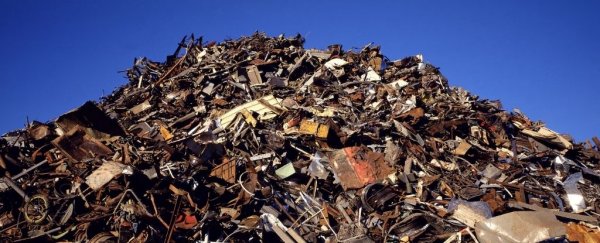The United States is home to nearly 2,000 active landfills. Each day, these enormous piles of garbage can leach well over 2 million liters of liquid per site into the soil, contaminating local water with potentially toxic substances.
These liquid-based pollutants are an immediate threat to both the environment and human health, yet figuring out which chemicals are the most dangerous and need to be tackled first is a tricky and expensive business, especially when there are so darn many, and we know so little about them.
A previous attempt at prioritizing pollutants in fracking water found 86 percent of the chemicals lacked the necessary toxicity data to complete a proper risk assessment. This is obviously a major limiting factor, but scientists can only work with the information they have.
Adapting this algorithm, researchers have now attempted to prioritize landfill contaminants in a similar way, creating a highly flexible system that can be customized for different landfill sites.
The authors hope this tool can one day be used to better monitor waste sites and make them less dangerous in the future.
"Leachate from landfills can cause cancer and other serious harm, and it's a threat whether it's ingested, inhaled, or touched," says Chung-Ho Lin, who studies agroforestry and bioremediation at the University of Missouri.
"This is the first time a system has been created that can automatically prioritize the pollutants released from a landfill based on their toxicity and abundance."
The new system is based on a thorough review of the literature, which turned up 484 landfill pollutants. In the end, the top 40 most toxic compounds included pesticides, fungicides, pharmaceuticals, and industrial byproducts, like those from cigarettes, coolants, lubricants, and flame retardants.
Of all those compounds, 21 were found to be potential or confirmed endocrine disruptors, 14 were identified as potential or confirmed human carcinogens, and 12 were found to cause neurological issues.
"Some of the most potentially harmful compounds that we identified using this scheme were from things like antibiotics or prescription medications, which could have serious impacts on the human endocrine system," explains Elizabeth Rogers, who also studies landfill remediation at the University of Missouri.
"There were also compounds from personal care products. And while we know these newer classes of compounds can have negative impacts, there is still a lot we don't know about them, and they're ending up in landfills."
This general scheme was then adapted to more specific categories, including a cancer-weighted scheme, a hormone disruption scheme, and a scheme that considers risks to flora and fauna.
If a region is struggling with rising cases of cancer, for instance, then agencies can use this more niche ranking to hone in on the worst offenders first.
For example, codeine and fluoranthene were found to pose a much greater risk for cancer compared to their overall general toxicity.
Other chemicals, like oxytetracycline (a common antibiotic) and clotrimazole (a common antifungal), were found to present both large cancer risk and large toxicity risks.
Fossil fuel byproducts, like naphthalene, and herbicides, like atrazine, were much more dangerous for flora and fauna of a site but had relatively lower overall toxicity risk.
"The flora and fauna weighted scheme lends itself well to implementation in an area where animal and plant life is of high concern or value," the authors explain, "for example: pristine natural areas, locations with endangered species, or places where human consumption of animals (through hunting or fishing) is common."
Unfortunately, the data on endocrine disruptors is still in its infancy, making it difficult to determine how many of these pollutants actually impact human hormones and to what extent. Only 26 percent of the compounds identified had available data on the parameters of endocrine disruption, and yet many of these compounds were in the top 40 general toxicity scheme.
Even with such limited understanding, however, promising solutions are emerging. Despite many landfill regulations not changing for decades, in recent years, there's been growing interest in restoring these sites with microbes, fungi, or plants that can stabilize soil or remove toxins from the water.
"In the past, we have mostly targeted the most common pollutants, such as herbicides and contaminants from crude oil," says plant geneticist Ronald Zalesny Jr. from the USDA Forest Service.
"Using this prioritization tool, we could now go to basically any contaminated site, identify the top contaminants and match those contaminants with our trees to create a sustainable, long-term solution for cleaning up pollution."
We've got a big mess to clean up. This tool will hopefully help us get started.
The study was published in the Journal of Environmental Management.
